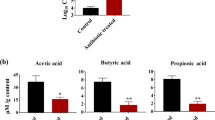Abstract
Recent studies suggest that Candida albicans colonization is associated with several gastrointestinal inflammatory disorders and is also responsible for the delay in ulcer healing. No data are reported about the effects of C. albicans on the nonsteroidal anti-inflammatory drugs (NSAIDs)-induced necroinflammatory lesions. On the other hand, beneficial effects of NSAIDs regarding the colonization potential with C. albicans have been reported. Our aim was to investigate whether the association between NSAIDs and C. albicans could potentially induce necroinflammatory lesions in the guinea pigs gastric and enteral mucosa. Three interventional groups of 11 guinea pigs each were investigated after 5 days of receiving indomethacin, C. albicans or the association of both. C. albicans and necroinflammatory lesions were graded based on histological examinations. Statistical analysis used Mann–Whitney nonparametric test. NSAIDs did not significantly decrease C. albicans colonization grades on gastrointestinal mucosa. Administration of indomethacin subsequent to C. albicans determined significantly more severe necroinflammatory lesions compared to group that only received C. albicans. The association of NSAIDs and C. albicans did not cause significantly more severe degenerative or inflammatory lesions compared to the administration of only NSAIDs in this experimental model. Associations between NSAIDs and C. albicans caused significantly more severe necroinflammatory injuries than the lesions produced by C. albicans, without enhancing the mucosal injury or inflammation caused by NSAIDs.





Similar content being viewed by others
References
Alem MAS, Douglas LJ. Effects of aspirin and other nonsteroidal anti-inflammatory drugs on biofilms and planktonic cells of Candida albicans. Antimicrob Agents Chemother. 2004;48:41–7.
Anthony A, Dhillon AP, Nygard G, et al. Early histological features of small intestinal injury induced by indomethacin. Aliment Pharmacol Ther. 1993;7:29–39.
Beck PL, Xavier R, Lu N, et al. Mechanisms of NSAID-induced gastrointestinal injury defined using mutant mice. Gastroenterology. 2000;119:699–705.
Fiorucci S, Antonelli E, Morelli A. Mechanism of non-steroidal anti-inflammatory drug-gastropathy. Dig Liver Dis. 2001;33(Suppl. 2):S35–43.
Graham DY, Opekun AR, Willingham FF, et al. Visible small-intestinal mucosal injury in chronic NSAID users. Clin Gastroenterol Hepatol. 2005;3:55–9.
Ilahi M, Khan J, Inayat Q, Abidi TS. Histological changes in parts of foregut of rat after indomethacin administration. J Ayub Med Coll Abbottabad. 2006;18:29–34.
Kock JLF, Sebolai OM, Pohl CH, et al. Oxylipin studies expose aspirin as antifungal. FEMS Yeast Res. 2007;7:1207–17.
Kock JLF, Strauss CJ, Pohl CH, Nigam S. The distribution of 3-hydroxy oxylipins in fungi. Prostaglandins Other Lipid Mediat. 2003;71:85–96.
Kock JLF, Swart CW, Ncango DM, et al. Development of a Yeast bioassay to screen anti-mitochondrial drugs. Curr Drug Disc. 2009;6:186–91.
Kumamoto CA. Inflammation and gastrointestinal Candida colonization. Curr Opin Microbiol. 2011;14:386–91.
Loh AH, Ong LY, Liew WK, et al. Multiple indomethacin-induced colonic perforations in an adolescent. Singapore Med J. 2011;52(4):e82–4.
Maiden L. Capsule endoscopic diagnosis of nonsteroidal antiinflammatory drug-induced enteropathy. J Gastroenterol. 2009;44(Suppl 19):64–71.
Nakamura T, Yoshida M, Ishikawa H, et al. Candida albicans aggravates duodenal ulcer perforation induced by administration of cysteamine in rats. J Gastroenterol Hepatol. 2007;22:749–56.
Newberry RD, McDonough JS, Stenson WF, Lorenz RG. Spontaneous and continuous cyclooxygenase-2-dependent prostaglandin E2 production by stromal cells in the murine small intestine lamina propria: directing the tone of the intestinal immune response. J Immunol. 2001;166:4465–72.
Noverr MC, Phare SM, Toews GB, et al. Pathogenic yeasts Cryptococcus neoformans and Candida albicans produce immunomodulatory prostaglandins. Infect Immun. 2001;69:2957–63.
Park SC, Chun HJ, Kang CD, Sul D. Prevention and management of non-steroidal anti-inflammatory drugs-induced small intestinal injury. World J Gastroenterol. 2011;17:4647–53.
Pyoung JS, Nayoung K, Joo-Hyon K, et al. Comparison of Indomethacin, diclofenac and aspirin-induced gastric damage according to age in rats. Gut Liver. 2012;6:210–7.
Rainsford KD. Mechanisms of gastrointestinal damage by NSAIDS. Agents Actions Suppl. 1993;44:59–64.
Tanaka A, Hase S, Miyazawa T, Takeuchi K. Up-regulation of COX-2 by inhibition of COX-1: a key to NSAID-Induced intestinal damage. J Pharmacol Exp Ther. 2002;300:754–61.
Vasquez-Torres A, Jones-Carson J, Warner T, Balish E. Nitric oxide enhances resistance of SCID mice to mucosal candidiasis. J Infect Dis. 1995;172:192–8.
Whittle BJ. Gastrointestinal effects of nonsteroidal anti-inflammatory drugs. Fundam Clin Pharmacol. 2003;17:301–13.
Yamada T, Deitch E, Specian RD, et al. Mechanisms of acute and chronic intestinal inflammation induced by indomethacin. Inflammation. 1993;17:641–62.
Zwolińska-Wcisło M, Brzozowski T, Budak A, et al. Studies on the influence of Candida fungal colonization on the healing process of inflammatory lesions in the colon in rat animal model. Przeql Lek. 2007;64:124–9. (Article in Polish).
Acknowledgments
This paper was supported by POSDRU/89/1.5/S/62371 project.
Author information
Authors and Affiliations
Corresponding author
Additional information
George C. Nadăş and Lidia Ciobanu contributed equally to this work.
Rights and permissions
About this article
Cite this article
Nadăş, G.C., Taulescu, M.A., Ciobanu, L. et al. The Interplay Between NSAIDs and Candida albicans on the Gastrointestinal Tract of Guinea Pigs. Mycopathologia 175, 221–230 (2013). https://doi.org/10.1007/s11046-013-9613-8
Received:
Accepted:
Published:
Issue Date:
DOI: https://doi.org/10.1007/s11046-013-9613-8




